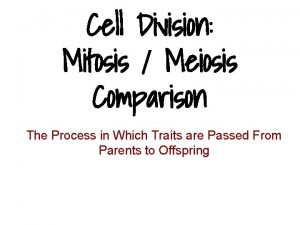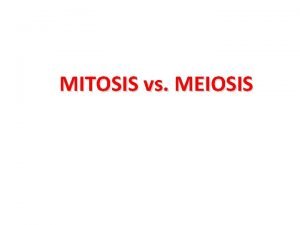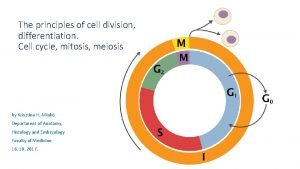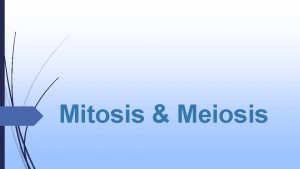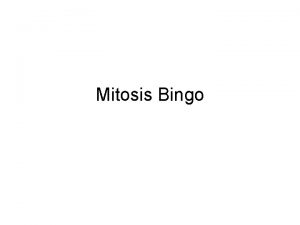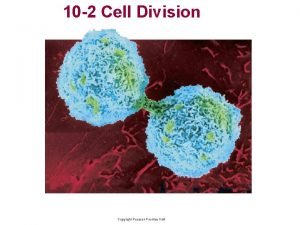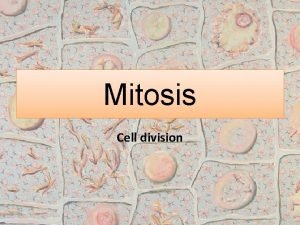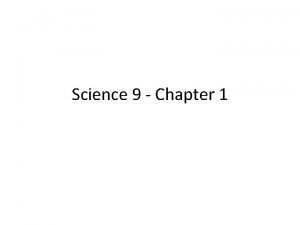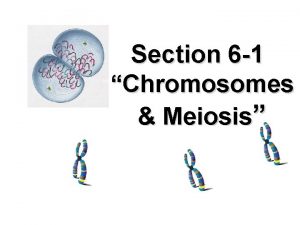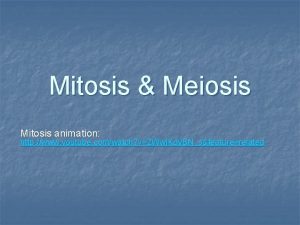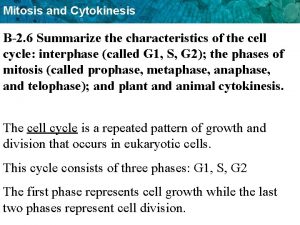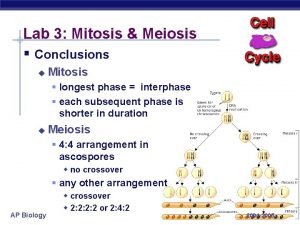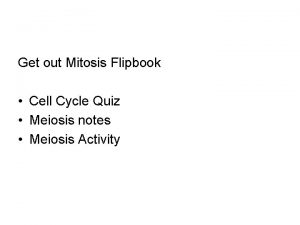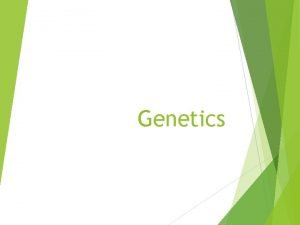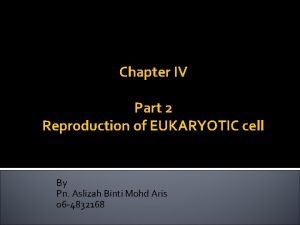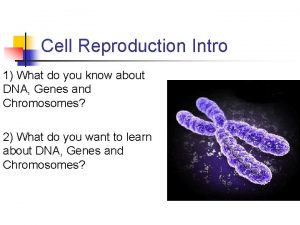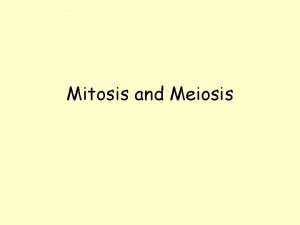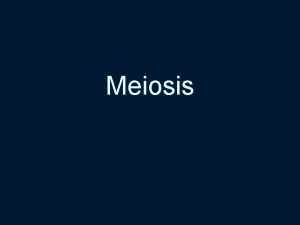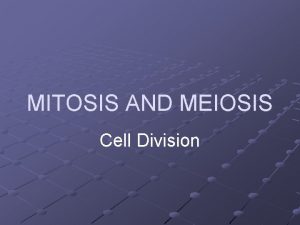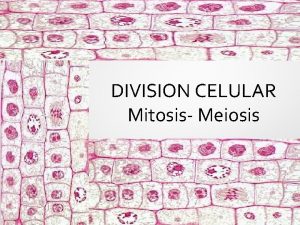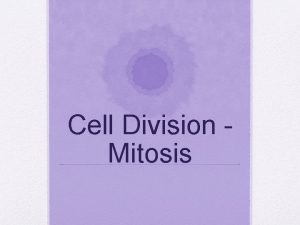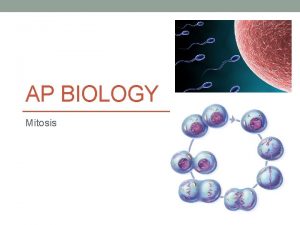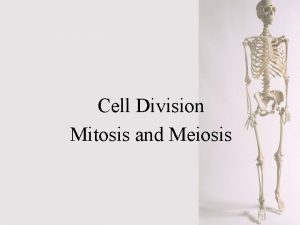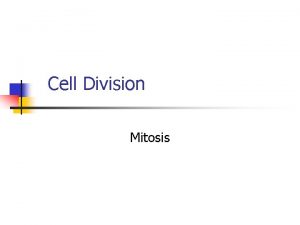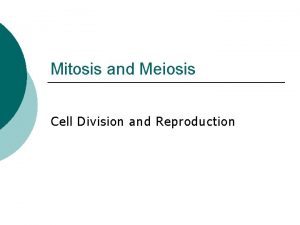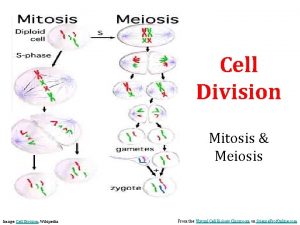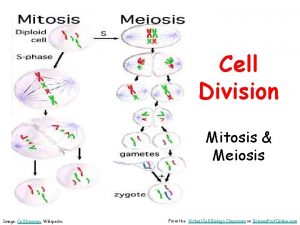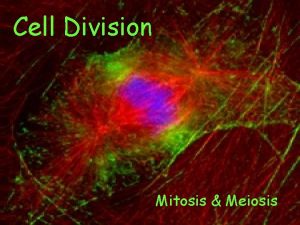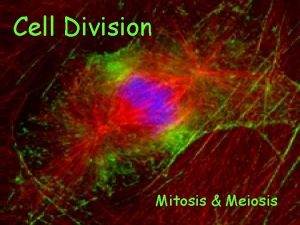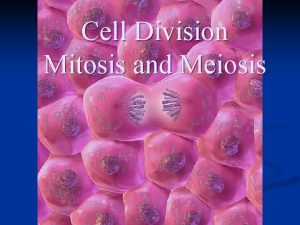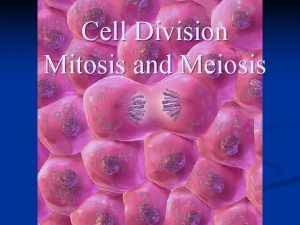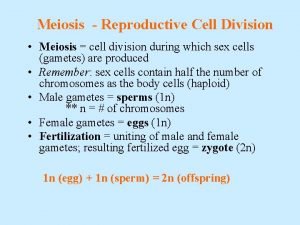Comparing types of cell division Mitosis and Meiosis





















- Slides: 21

Comparing types of cell division Mitosis and Meiosis

Prokaryotic Cells Divide by Fission �Most prokaryotes have 1 circular chromosome Replication begins at “ori”, moves through replication complex and ends at site called “ter” 2 “ori” regions on the 2 chromosomes attach to cell membrane; as cell grows longer, chromosomes separate �Cytokinesis begins about 20 min after replication done


Eukaryotic Chromosomes �Made of chromatin – DNA and associated proteins �When cell isn’t dividing, chromosomes partly unraveled �During cell division, chromatin fibers condense into distinct chromosomes

� 2+ meters of DNA/human cell Must be packaged to avoid tangling �Form nucleosomes Spool that keeps DNA from tangling �Scaffolding proteins also maintain chromosome structure �During mitosis and meiosis, nucleosomes pack more tightly together


Eukaryotic Cells �Have many chromosomes Replication and segregation is more intricate �Cytokinesis is distinct from division of genetic material Differs in plants and animals

Why do cells divide? �When cells reach a certain size they either: Stop growing Divide �Volume increases faster than surface area Needed materials cannot diffuse through volume of cell efficiently

Mitosis � Nuclear Division � 4 Stages: Prophase Metaphase Anaphase Telophase � Mitosis is followed by cytokinesis Cleavage furrow in animal cells Cell Plate in plant cells � http: //www. loci. wisc. edu/outreach/bioclips/CDBio. html � http: //highered. mcgraw-hill. com/sites/0072437316/student_view 0/chapter 11/animations. html#




Sexual Reproduction �Union of 2 gametes to form single zygote �Results in genetic variation of offspring �Gametes are haploid Contain 1 of each homologous chromosome Produced by meiosis

Meiosis � Cell division that reduces the # of chromosomes � http: //www. stolaf. edu/people/giannini/flashanimat/celldivisi on/meiosis. swf � Diploid cells undergo 2 cell divisions 4 haploid cells � 4 key ways meiosis differs from mitosis: 2 nuclear and cytoplasmic divisions 4 cells DNA duplicates once, but nucleus divides twice Resulting cells are haploid Shuffling of homologous chromosomes so each haploid cell is unique

First Meiotic Division: Meiosis I Prophase I – synapsis – homologous chromosomes lie side by side Forms tetrad (4 chromatids) Proteins hold homologues together Crossing-over occurs between homologues, resulting in genetic recombination

Meiosis I, cont. �Metaphase I Chromosome pairs (tetrads) line up on midplane �Anaphase I Paired homologues separate and move to opposite poles �Telophase I Chromatids decondense some �Interkinesis, brief stage, may follow

Meiosis II

Spermatogenesis in Vertebrates �Occurs in seminiferous tubules of testes �Spermatogonia (undifferentiated) go through mitosis to make 1 o spermocytes (2 n) � 1 1 o spermatocyte 2 2 o spermatocytes 4 spermatids of equal size

Oogenesis in vertebrates � Occurs in ovaries � Oogonia form during embryonic development and increase in size to become 1 o oocytes (2 n) � At birth, they are in prophase I – enter resting stage � Puberty – 1 o oocytes completes meiosis I Cytoplasm/organelles not divided evenly, form 1 2 o oocyte and first polar body (may divide)

Oogenesis, cont. � 2 o oocyte begins 2 nd meiotic division, but remains in metaphase II until fertilized �After fertilization, meiosis II continues, forming 1 ovum and 2 nd polar body �Polar bodies eventually disintegrate Provide a place for chromosomes to go

 Mitosis meiosis
Mitosis meiosis Meiosis
Meiosis Does crossing over occur in both mitosis and meiosis
Does crossing over occur in both mitosis and meiosis Complete the concept map comparing mitosis and meiosis
Complete the concept map comparing mitosis and meiosis Concept map comparing mitosis and meiosis
Concept map comparing mitosis and meiosis Venn diagram mitosis and meiosis
Venn diagram mitosis and meiosis Mitosis
Mitosis Cell cycle and cell division
Cell cycle and cell division Cell cycle and cell division
Cell cycle and cell division Cell cycle phases in order
Cell cycle phases in order Comparison of mitosis and meiosis table
Comparison of mitosis and meiosis table Write difference between mitosis and meiosis
Write difference between mitosis and meiosis Kesler science mitosis and meiosis answer key
Kesler science mitosis and meiosis answer key Haploid and diploid venn diagram
Haploid and diploid venn diagram Youtube
Youtube Characteristics of mitosis and meiosis
Characteristics of mitosis and meiosis Mitosis and meiosis escape room answer key
Mitosis and meiosis escape room answer key Conclusion of mitosis and meiosis
Conclusion of mitosis and meiosis Mitosis flipbook
Mitosis flipbook Chromosomes in organisms
Chromosomes in organisms Chromosome sets (=n) in mitosis and meiosis
Chromosome sets (=n) in mitosis and meiosis Characteristics of mitosis and meiosis
Characteristics of mitosis and meiosis
